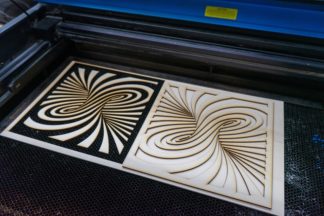By Erinn Aspinall

Photo of positive and negative cuts from a laser cutter.
Libraries are all about information so it makes perfect sense that we provide state-of-the-art collections that include 3D anatomy resources, evidence-based point of care tools, and historically significant rare books and artifacts that document the history of medicine.
But information isn’t static and the development of new knowledge needs to be cultivated in a supportive environment — that’s where libraries and technology go hand in hand.
Exploring laser cutting
Our staff recently took its first “summer camp” trip to the Anderson Student Design Lab in Mechanical Engineering and met with Ben Guengerich, Lab Manager. The goal of the camp was to provide an introduction to laser cutting — a technology that will be available in our Makerspace when we move into the new Health Sciences Education Center.
“Laser cutters are one of the most popular and fun tools in any makerspace since they can easily cut and engrave everything from paper to plywood to acrylic and even metal,” says Jonathan Koffel, Emerging Technology and Innovation Strategist at the Bio-Medical Library.
Laser cutters also allow for extremely fine and precise cuts, which could have real benefits for health sciences — from creating a “lab on a chip” that uses tiny amounts of liquid to diagnose diseases or run scientific experiments to creating new medical devices or assistive tools.
Libraries as a place for learning
“The potential when merging libraries and technology are tremendous since together they allow an individual to take a question, research an answer, problem-solve a solution, and widely share the knowledge gained and solutions developed,” says Koffel.
“That people can do this all in one place with support from experts is even more exciting, providing real opportunities to support advances in teaching, learning, and practice.”
Next stop for our library summer camp — back to the Anderson Student Design Lab for high resolution 3D printing and milling. We can’t wait.




